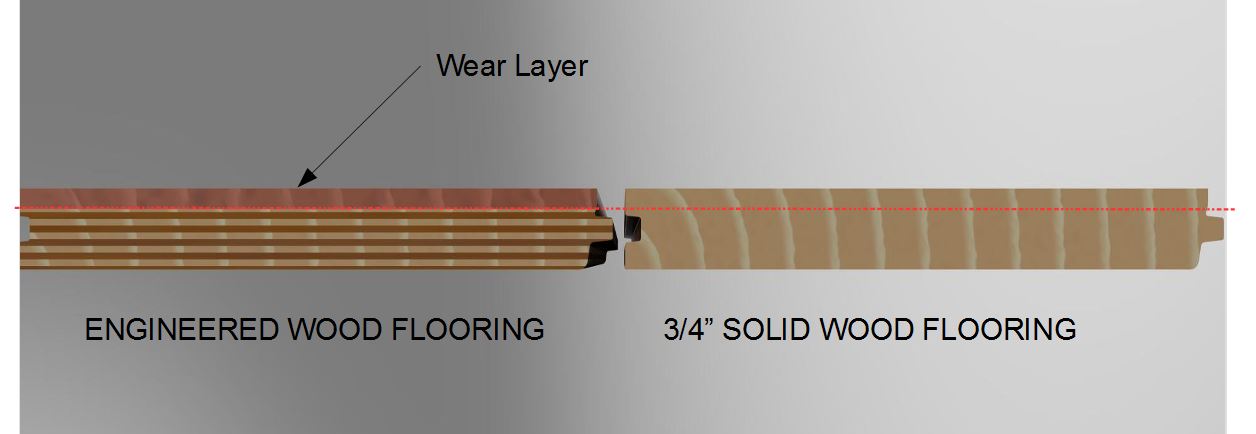There are many benefits of selecting an engineered floor construction over a solid floor construction when choosing a new hardwood floor for your home. For a more in depth look at the construction and benefits of engineered flooring, you should also read our “All About Engineered Wood Floors” article.
First A Brief Overview of Engineered Flooring
An engineered floor is constructed using an inner core made up of anywhere from 3 to 12 cross layers of plywood (typically made of hardwood, birch or pine) which are glued and pressed together. A layer of the desired decorative wood species is then fused on top of this inner core. This top layer is what you’ll see once the flooring is installed and is commonly referred to as a “wear layer.”
One may choose engineered over solid hardwood flooring because the cross layers of engineered flooring allow this type of hardwood construction the ability to be installed in more areas of the home, including below grade levels (basements) and over radiant heat. The cross layers will reduce expansion and contraction, which in turn minimizes gapping and buckling when the moisture in the room's atmosphere changes.

Benefits of a Thicker Wear Layer
Engineered flooring wear layer thicknesses really vary from product to product and there is a huge range of thicknesses available on the market right now. You can currently find products with paper thin wear layers of .6mm at one end of the spectrum and then 4mm and thicker at the opposite end.
The main reason the wear layer thickness is important in your decision making process is that it basically dictates how many times a particular engineered floor can be sanded and refinished. Sanding and refinishing a hardwood floor is not generally something that homeowners do very often. Typically, it’s something that would be done if your flooring is showing a lot of wear, scratches, dents, etc. and you would like to give the hardwood a bit of a face lift, taking it back to its original and new looking appearance. This process involves taking a tiny bit of the wear layer off to remove the scratches and dents by sanding the entire floor. Then, a coat of finish would be applied to the hardwood to restore the original sheen.
When a floor is sanded and refinished, a small portion of the wear layer thickness is being removed. Sand past the total thickness of the wear layer of that particular engineered floor and you’ll get to the cross layered plywood core. This is how the thickness of a wear layer becomes important in selecting an engineered floor. An engineered floor with a very thin wear layer, for example a 1mm thickness, cannot be sanded and refinished at all over the lifetime of the floor which can lessen the floors lifespan quite a bit compared to styles that have thicker wear layers.
Keep in mind that any future sanding and refinishing a hand scraped floor will remove the textured look you originally desired, so you may only wish to lightly hand sand and re coat the flooring (if ever needed.
How many times can an engineered floor be sanded and refinished?
An engineered floor with a 1mm wear layer cannot be sanded and refinished to remove deep scratches, it can only be recoated.
*Approximate lifespan 15-25 years
An engineered floor with a 2mm wear layer can be sanded and refinished approximately 1 to 2 times over the lifetime of the floor.
*Approximate lifespan 30-40 years
An engineered floor with a 3mm wear layer can be sanded and refinished approximately 2 to 3 times over the lifetime of the floor.
*Approximate lifespan 40-50 years
An engineered floor with a 4mm wear layer or thicker can be sanded and refinished approximately 3 to 5 times over the lifetime of the floor.
*Approximate lifespan 50-80 years
*Lifespan depends on the quality of maintenance and the number of times the floor is sanded and refinished. It has been stated that the average homeowner has their hardwood flooring sanded and refinished every 15 -20 years. We have seen many homes with hardwood floors that are 30 years or older that have never been refinished and still look new. Hardwood flooring still has the greatest value for its longevity when compared to other types of floor covering.





